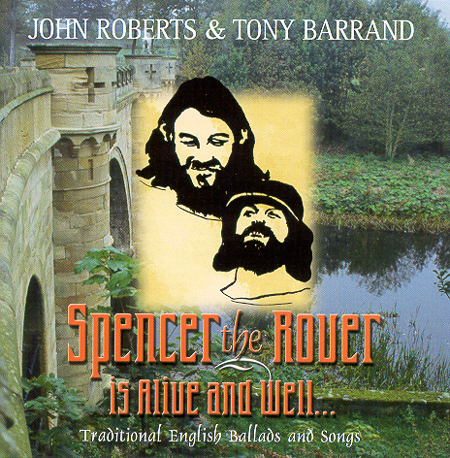|
1. SPENCER THE ROVER
One of the first songs we learned when we started to sing together. It comes from the Copper family of Rottingdean, Sussex just before the turn of the century. They were singing their songs in harmony long before that, something relatively rare in the English tradition.
2. CREEPING JANE
The song is of the Stewball variety, but lacks the moral so prevalent in American folk songs.
3. I WISH THE'D DO IT NOW
Originally an American Pseudo-Irish minstrel show song, this version comes from Bob Davenport, a fine singer in this music hall tradition.
4. RAMBLEAWAY
A very common song in the English tradition, especially in the South.
5. WHAT A MOUTH!
A cockney music hall song, is somewhat streamlined from the original which was written by R.P. Weston in 1906. It was sung by Harry Champion, who made famous "Any Old Iron" and "I'm Henery the Eight I Am." I think our version came from Tommy Steele.
6. THE NIGHT AND THE SHEPHERD'S DAUGHTER
This ballad is the sole representative here of those which professor child considered breat enough to include in his collection. Our version escaped across the water to the Maritime Provinces of Canada, where it was collected by Helen Creighton as late as 1954. It lacks the "happy ending" often found in other variants, where the wronged maiden turns out to be a lady far richer than the knight who seduced her.
7. SILICOSIS
The "Potteries" area of norther Staffordshire, home of Wedgewood, Doulton, and other major pottery makers, consists of five towns: Stoke, Hanley, Bursllem, Fenton and Longton (reffered to as "Neckend" in the song). The smoke from the potbanks and the clay dust in the factories made silicosis the major killer. Then in the 1950s, Harold Clowes was elected Lord Mayor of Stoke-on-Trent. He set about cleaning up the area, banning the potbanks, and making the owners install electric kilns. the dialect song was written by Bob Wilson, a native of Stoke-on-Trent, and Tony learned it from him in 1964. The "snappin" mentioned in the song is the factory man's lunch.
8. THE COACHMAN
The sybolism of the coachman's "whip" is rarely lost on listeners. The song is traditional and a popular one in English folk clubs.
9. THE LINCOLNSHIRE POACHER
This is one of those songs that everyone in England learns in elementary school, then forgets as rapidly as possible. Michael Cooney has said that everyone in grade school thinks they are corny and crummy: he now contends that it is grade school that is corny and crummy, not the songs. We agree.
10. WARLIKE SEAMEN
This song about a seabattle is a common one, sometimes appearing as The Dolphin, or The Irish Captain. Our version is another from the repertoire of the Coppers.
11. DAHN THE PLUGHOLE
This tragic little ditty is another example of the Cockney music hall of London. it is perhaps best known to American audiences through the recording by Cream.
12. SHINE YOUR BUTTONS WITH BRASSO
Tony relates that he used to sing this turgid dirge at school as a youngster behind the boys' toilets.
13. MARTIN SAID TO HIS MAN
William Chappell, in "Popular Music of the Olden Time," gives a text of this drinking song, which dates back to the 16th century. he supposes it to be a satire on those who tell wonderful stories: we tend to think of it as a political allegory, though we have not yet made up the folklore to go with this theory.
14. FANNY BLAIR
A. L. Lloyd, in his book "Folk Song in England," remarks that this tune collected by Cecil Sharp in Somerset provides a striking example of the variability of the third and seventh steps in the "modal folk song scale." Sharp had Fanny Blair accusing a youth of robbery; here, at eleven years of age, she is accusing an apparently innocent young man of rape.
15. SO GREEN AS THE LEAVES
Also know as "The Shoemaker's Kiss," this song was collected by H. E. D. Hammond in Dorset, in 1906. It was printed on a broadside (penny song sheet) more than 50 years before that. The shoemaker's kiss is equivalent to Young Rambleaway's attentions to Nancy - at least the wrench of this tale knew where her deceiver was to be found.
16. BABYLON IS FALLEN
Helen Schneyer used to live close to Washington D.C., and opened her "soup kitchen" to a motly assortment of waifs, strays and folk singers. We sat around her table in November 1969 (after feasting on her wonderful chicken soup) and sang this from a hymnbook. It is printed in George Pullen Jackson's "Spiritual Folk Songs of Early America," and is the only truly American song that we sing here.
17. THYME
Thyme often symbolizes virginity in the English tradition. We learned this version from Michael Cooney.
|

